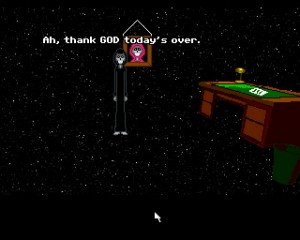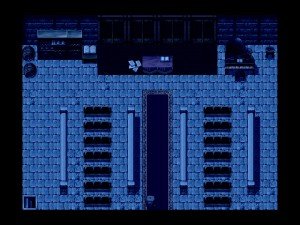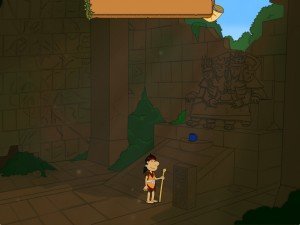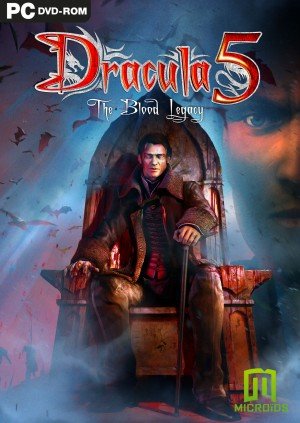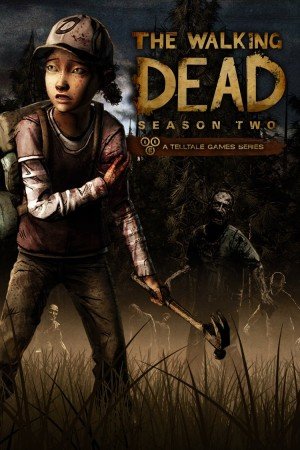Following Freeware: December 2014 releases
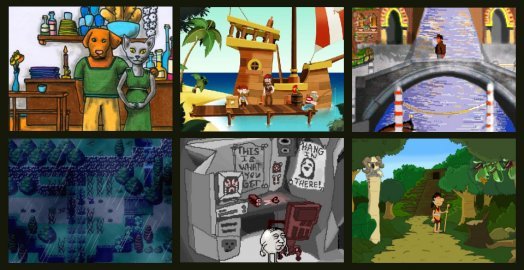
This month you can travel to the Lands of Dream, a version of hell populated by ball people, or simply stay seated at a computer console. You could take on the role of a goat herder trying to prevent his charges from being sacrificed, a police inspector seeking a serial killer, or a famous adventurer on a quest for a new historical artifact. Alternatively, you might embark on a piratical quest for ultimate treasure, attempt to lift a family curse, or enjoy a well-known designer’s early work updated to run on modern machines. All these await you in this month’s (and some leftovers from last month’s) round-up of releases from the freeware scene.
Steve's Selections
A Postcard from Afthonia
In the Lands of Dream, the forces of Lord Urizen continue to wage war on the citizenry. Urizen’s ultimate goal is to sack the fabled city of Oneiropolis, but for now he is laying siege to the Fortunate Isles. The inhabitants of the largest island, The Isle of the Sun, resist the siege fiercely. But even as they fight for their freedom, they must plan for the future. One young couple, soon to have a child, would seek counsel from the Oracle. Alas, her remote island home lies beyond the besieging fleet. Unable to get to the Oracle themselves, the couple reach out with a postcard sent as a portal to the waking realm. The intended recipient is a hero that has thwarted Lord Urizen’s schemes in the past. Can this noble figure find a way to rescue the Oracle and bring hope to the people?
 This game is a sequel to Jonas Kyratzes’ commercial release The Sea Will Claim Everything. The art style uses the same hand-drawn slideshow format of the previous game, with bright colours predominating. The style is reminiscent of a fairy-tale storybook, matching the tone of the adventure perfectly. Returning players will visit many of the same locations, such as the wharf and the restaurant where the goat Kostas continues his apparently endless meal. You will also meet old friends, such as the goat and the summoning couple you originally helped bring together. There are some changes, however. The depredations of Lord Urizen are having an effect, most notably the smoke from his invading fleet and tar washing up on the beaches. There are also new locations to explore, as you seek a new route to the Isle of the Oracle. The action is backed up by gentle folk music that fits in well with the setting.
This game is a sequel to Jonas Kyratzes’ commercial release The Sea Will Claim Everything. The art style uses the same hand-drawn slideshow format of the previous game, with bright colours predominating. The style is reminiscent of a fairy-tale storybook, matching the tone of the adventure perfectly. Returning players will visit many of the same locations, such as the wharf and the restaurant where the goat Kostas continues his apparently endless meal. You will also meet old friends, such as the goat and the summoning couple you originally helped bring together. There are some changes, however. The depredations of Lord Urizen are having an effect, most notably the smoke from his invading fleet and tar washing up on the beaches. There are also new locations to explore, as you seek a new route to the Isle of the Oracle. The action is backed up by gentle folk music that fits in well with the setting.
As the events in this game follow on from the conclusion of its predecessor, it undoubtedly helps to have played that game first, especially as the characters treat the player as a returning hero. However, using the in-game explanation of time working differently in the Lands of Dream, players can claim that they have not visited before and get a summary of events. Control is single-click, with many of the small details in each location having their own humorous descriptions. A side panel contains arrows showing which will take the player to a neighbouring location, but this only covers the immediate locale, such as the streets of Afthonia. To travel larger distances, a magical map allows instant travel across the island. A lot of gameplay revolves around finding new locations for the map, usually gleaned from conversations with the varied denizens of the area. A magical scroll also keeps track of tasks you have accepted. You will also acquire a small amount of inventory which is used automatically when you click on an appropriate place or person. As in Kyratzes' previous games, the wealth of background detail in both scenery and conversation brings the setting to life.
A Postcard from Afthonia can be downloaded from the developer’s website. A special edition including audio commentary and other bonus content is also available for a small fee.
Mu Complex: Episode One
Having only just gained access to Mu Complex, you start with the simplest access to its computer systems. But this is an establishment that rewards a problem-solving mindset. Your aptitude test for advancing in the Complex’s hierarchy shows that you know how to circumvent the basic low-level systems. As you progress up through the levels of security, more is revealed about the projects that the complex has been working on. Just how long has the complex been in operation and what were they creating in that sealed lab? What sealed lab?
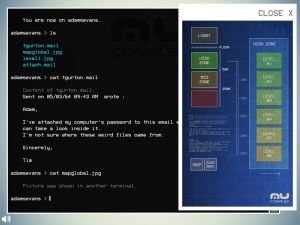 StudioCime have created an intriguing sci-fi story that promises to be the opening chapter of a much larger tale. Initially the game presents you with a logo for the complex and a simple command line interface. Almost all interaction with the game is done through this interface, with “help” providing a list of available commands. At the start these are single words, but soon you need to enter multiple word commands to progress. Whilst most text is white on black background, colour is used to good effect to achieve such things as distinguishing command terms from their descriptions. Later you will also access picture files, including photos and diagrams of the local computer network. Each level of the game is introduced with instructions read out in a gentle female computer voice. An ambient high sci-fi piece plays in the background.
StudioCime have created an intriguing sci-fi story that promises to be the opening chapter of a much larger tale. Initially the game presents you with a logo for the complex and a simple command line interface. Almost all interaction with the game is done through this interface, with “help” providing a list of available commands. At the start these are single words, but soon you need to enter multiple word commands to progress. Whilst most text is white on black background, colour is used to good effect to achieve such things as distinguishing command terms from their descriptions. Later you will also access picture files, including photos and diagrams of the local computer network. Each level of the game is introduced with instructions read out in a gentle female computer voice. An ambient high sci-fi piece plays in the background.
Cracking the opening level is simplicity itself, but the puzzles get more complex as you get higher up. You will need to switch between computers and decipher codes and riddles within the game’s various files. You will also operate computer-controlled devices, with a camera feed providing hidden clues when the light and viewing filters are changed. There is one puzzle that will require the player to truly think outside the box. As well as providing the clues you need to progress, the various files you access give you background information about the complex itself. This allows you to slowly build up a picture of its purpose in a very natural fashion. Whilst the game comes to a satisfying conclusion, the final revelation should serve as a jumping-off point for further tales in this setting.
Mu Complex can be played online at Kongregate.
The Repossessor (2014)
After a hard day gathering souls, Death was looking forward to being able to relax for a bit. Unfortunately, The Powers That Be have other ideas with an urgent assignment for him. It appears that one Michael Gower, formerly deceased, has been returned to the realm of the living by black magic. This affront to the laws of mortality cannot be allowed to stand, and Death is despatched to return him to the afterlife. But Gower is technically alive again, albeit as a zombie, and flatly refuses to return. It looks like Death is going to have to get creative to get the job done.
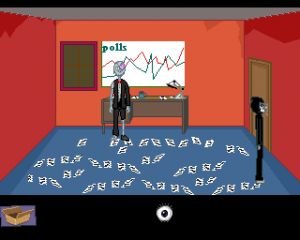 Adventure game fans may be familiar with the developer of this game: none other than Wadjet Eye’s Dave Gilbert. The original version was created as part of shared setting Reality-on-the-Norm back in August 2001, representing Dave’s first foray into the world of adventure gaming. Whilst the essentials of the game are unchanged, it has now been updated to run on modern computers. The graphics are done in a pixel art style. The game takes place in central Reality, consisting of a local hostelry, Scid’s Bar and its nearby alley. Death appears as a thin figure in a full-length hooded robe and the zombie Gower is missing several parts. A jaunty tune plays through the main square, to be replaced by an instrumental version of “Don’t Fear the Reaper” in Scid’s and a disco anthem in the alley.
Adventure game fans may be familiar with the developer of this game: none other than Wadjet Eye’s Dave Gilbert. The original version was created as part of shared setting Reality-on-the-Norm back in August 2001, representing Dave’s first foray into the world of adventure gaming. Whilst the essentials of the game are unchanged, it has now been updated to run on modern computers. The graphics are done in a pixel art style. The game takes place in central Reality, consisting of a local hostelry, Scid’s Bar and its nearby alley. Death appears as a thin figure in a full-length hooded robe and the zombie Gower is missing several parts. A jaunty tune plays through the main square, to be replaced by an instrumental version of “Don’t Fear the Reaper” in Scid’s and a disco anthem in the alley.
For Death to succeed in his mission, you need to find a way to separate Gower from his new body. Using the standard AGS four-action interface, you must navigate the town and deal with its denizens. A bit of exploration turns up a spell that should do the trick, but then it is a matter of getting the ingredients. Of course, this being an adventure game, that is no simple matter. To get what you need, you will have to negotiate with a hostile chicken and find a new disco ornament for the dancing-obsessed bum. As may be gathered, this is not a tale to be taken seriously, with a good sense of humour conveyed throughout. The game ends with a twist that originally resulted in both main characters becoming central to the recurring cast of many subsequent Reality games.
The Repossessor (2014) can be downloaded from the AGS website.
Pachinko Man
You have tried to lead a good life, working hard and avoiding most vices. But there is one addiction you have been unable to resist, the game of Pachinko. The thrill of watching those shiny metal balls bounce down through the pins, hoping they will hit a winning spot, is too much for you. When you heard of a fabled Pachinko machine that could make your wildest dreams come true, you could not resist its lure. Sadly, the forfeit for losing was as grandiose as the prize for winning. Now you have been turned into a living Pachinko ball and relegated to a cubicle in Ball Hell. Trapped in a strange shape in the most nightmarish office ever conceived, you resolve to achieve something no-one else has ever done: escape from Ball Hell.
 This game from Punch the Moon has a darkly comic tone to it. The graphics feature a pixelated cartoon style, with drab colours accenting the depressing nature of the setting. You start in a cubicle adorned with depressing “motivational” art. You will also visit a conference room and a cave containing a giant three-headed dog. The protagonist is a ball with a human face and stubby arms and legs, and many of your fellow inmates are similarly designed balls, though from a variety of games. You will also meet the diverse staff of Hell, including flaming skeletons and a dragon manager. All are simply but effectively animated. The background music is a predominantly brass piece with slightly Oriental tones to match the protagonist’s characterisation as a Japanese office worker. There are also limited sound effects, most notably a descending tone played upon your death.
This game from Punch the Moon has a darkly comic tone to it. The graphics feature a pixelated cartoon style, with drab colours accenting the depressing nature of the setting. You start in a cubicle adorned with depressing “motivational” art. You will also visit a conference room and a cave containing a giant three-headed dog. The protagonist is a ball with a human face and stubby arms and legs, and many of your fellow inmates are similarly designed balls, though from a variety of games. You will also meet the diverse staff of Hell, including flaming skeletons and a dragon manager. All are simply but effectively animated. The background music is a predominantly brass piece with slightly Oriental tones to match the protagonist’s characterisation as a Japanese office worker. There are also limited sound effects, most notably a descending tone played upon your death.
Hell being the dangerous place it is, death can be quite a common occurrence. These mostly result from player actions, with the risk of death being fairly evident in each case. Occasionally you will also need to act moderately quickly to avoid a particular hazard. Fortunately, as you are already in Hell, death just results in you being sent back to your starting cubicle with your inventory intact. Interaction is largely single-click, but lists of actions are presented when more than one interaction is possible. Puzzles satirise office life, with a group trapped for a 1,000 years by a presentation they have to finish watching, becoming stuck on a slide partway through. There is also a combination puzzle to overcome. You will need to interact with your fellows, including a gung-ho American pinball. Your efforts are continually mocked by the ruler of Ball Hell, Baal, whose dialogue is shown coming through wall-mounted speakers.
Pachinko Man can be played online at the developer’s website.
The Stoneville Mystery
For as long as you can remember, you have lived in the remote village of Stoneville with your father. He runs the local church but, whilst he loves you, there always seems to be something disturbing him. One dark and stormy night you wake to find yourself alone in the house. Your father has always told you never to go out at night, but you fear something terrible has happened. With spirits rising in the woods, it seems your father could be in grave danger. Just what would drive him to take such risks?
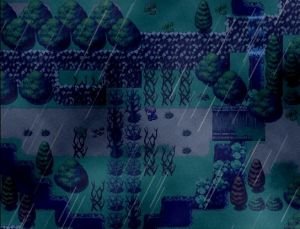 This game from Fuffydud presents a moderately dark story in a light fantasy setting. The presentation is done in a retro RPG style, with a top-down view and a grid-based system of movement. Thanks to the dreary weather and night-time setting, much of the environment is dark, with driving rain in the exterior scenes. A few of the town’s other inhabitants are up and about however, and the pub especially is brightly lit. Out in the forest you will also find some mysterious ruins to explore. The animations are fairly simple but work well with the artwork, the rain effect in particular being nicely done. Gentle orchestral pieces back up the action, though this has to compete with the ongoing storm somewhat. There are also sound effects at appropriate points, such as the noise of removing some nailed-up boards.
This game from Fuffydud presents a moderately dark story in a light fantasy setting. The presentation is done in a retro RPG style, with a top-down view and a grid-based system of movement. Thanks to the dreary weather and night-time setting, much of the environment is dark, with driving rain in the exterior scenes. A few of the town’s other inhabitants are up and about however, and the pub especially is brightly lit. Out in the forest you will also find some mysterious ruins to explore. The animations are fairly simple but work well with the artwork, the rain effect in particular being nicely done. Gentle orchestral pieces back up the action, though this has to compete with the ongoing storm somewhat. There are also sound effects at appropriate points, such as the noise of removing some nailed-up boards.
Whilst the task is initially just to find your father, you soon discover a larger quest. Your family line appears to have fallen under a curse, which your father is trying to break. Control is handled entirely by keyboard, moving around with the arrow keys and using X to interact with whatever you are facing. Diligent exploration, as well as assisting your neighbours, will help you acquire the items you need. Where a piece of furniture contains an object, a notable difference from similar furniture will draw your attention to it. Some small items lying on the ground also glint to give away their presence. You will need to solve a riddle to open an ancient doorway, and there are a couple of brief puzzles that require dexterity on the keyboard. It is possible to die in both of these sequences, but the game prompts you to save before you put yourself at risk.
The Stoneville Mystery can be downloaded from the RPG Maker website.
Stachmou and the Golden Compass
Legends tell of a sailor who discovered the Golden Compass, a mystical device that was supposed to direct its user to vast hoards of treasure. The last known holder of this device, Jack Treepwood, has not been seen since he set off for lost “TAOKI” island. Excited by the tales he has heard of this wonder, young pirate Stachmou embarks on his own search for this fabled artefact. But without the compass to guide him, even locating “TAOKI” island is going to prove a taxing challenge.
 Didier Guagliano’s piratical tale is the quest for the secret to finding all treasures. The graphics use a cartoon style, though with a detailed, realistic look overall. Stachmou himself wears the traditional stripy jersey and bandana of a low-level pirate, but is distinguished by a huge moustache. Your journey will take you from the toilets of the local pirate bar to a monkey-infested tropical island. The characters are well animated, complete with background motions such as the barman polishing glasses. Ambient sound consists of noises appropriate to the current setting, including the cries of jungle animals. There are also sound effects for player actions. Dialogue is solely voiced as a mumbling noise, though the mumbling differs between characters.
Didier Guagliano’s piratical tale is the quest for the secret to finding all treasures. The graphics use a cartoon style, though with a detailed, realistic look overall. Stachmou himself wears the traditional stripy jersey and bandana of a low-level pirate, but is distinguished by a huge moustache. Your journey will take you from the toilets of the local pirate bar to a monkey-infested tropical island. The characters are well animated, complete with background motions such as the barman polishing glasses. Ambient sound consists of noises appropriate to the current setting, including the cries of jungle animals. There are also sound effects for player actions. Dialogue is solely voiced as a mumbling noise, though the mumbling differs between characters.
Control is limited to a single-click, with the cursor changing when you are pointing at something you can interact with. The shape of the cursor gives an indication if you can look, take, interact or talk. Often you will only be able to take or interact with something after looking at it, the smart cursor changing after initial inspection. Diligent exploration and a bit of nifty inventory combination will see you though such tasks as finding a way for a sailor to disguise his alcohol-laden breath, and locating a lost map to the fabled island. There is also a colour-based combination puzzle to be solved.
Stachmou and the Golden Compass can be played online at JayisGames.
Willem's Winners
Sisyphus Reborn
You wake up in a dark cave all alone. Once outside, you find yourself in a desert in which everyone you meet digs deep holes in the ground.
"Why do you dig?" you ask.
"We dig to live."
"Why live?"
"We live to dig."
Eventually you are pointed to a white pyramid that opens after you play a sequence of tones on the bells that hang on a pole in front. Its inhabitant tells you about the meaning of everything and why the people in the desert are digging. He then lets you choose what to do with your life in the desert.
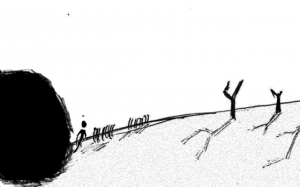 Sisyphus Reborn, by Emont, features simple but beautiful black and white sketch-style graphics. While moving your character around using the mouse, the desert around you shimmers in the heat. The grass and trees look like they are suffering, and heaps of sand fall apart once you start to climb them. You’ll hear the people dig away and scrape at the rocks they find, while the background music, which is very beautiful and soothing, gives an extra layer of atmosphere to the whole experience. Lacking voices, all text is displayed on the screen.
Sisyphus Reborn, by Emont, features simple but beautiful black and white sketch-style graphics. While moving your character around using the mouse, the desert around you shimmers in the heat. The grass and trees look like they are suffering, and heaps of sand fall apart once you start to climb them. You’ll hear the people dig away and scrape at the rocks they find, while the background music, which is very beautiful and soothing, gives an extra layer of atmosphere to the whole experience. Lacking voices, all text is displayed on the screen.
Since there are only a few very simple inventory and music puzzles, this game is better described as a profound philosophical experience about key choices in life rather than a traditional adventure. All elements of the game (for want of a better word) work together to make you feel that. It starts with a sort of figurative birth, emerging out of the darkened cave and into the light, and the journey can be seen as a very simple model of life: one day you will face the choice to either try to make something of your life, or do nothing. That choice is not always easy – certainly not for the protagonist here, who finds himself in a world where the only thing that can be done is to dig. You might think that starting to dig is the only way to end the game, but there are actually four endings in total. Three of those endings can be chosen by you, and hopefully you will find one thing that satisfies you in the long run, which is the “real” ending of the game.
Sisyphus Reborn can be downloaded from the Adventure Game Studio website.
Indiana Jones and the Gold of Genghis Khan
Indiana Jones needs no introduction: everyone knows him from the famous film series and almost-equally famous (at least among genre fans) adventure game. Now a new free adventure, Indiana Jones and the Gold of Genghis Khan, by Gabarts Digital, has arrived in which Indiana gets a letter from a friend in Venice, who claims he may have found a lost diary of Marco Polo. Indy hurries to Venice, only to find that the city is full of fascist soldiers who are guarding the city for Hitler's imminent visit. Indy has to come up with some clever plans to thwart them and find a way to his friend's antique shop. Amongst other objectives, this requires Indy to tame a seagull using a special concoction, pose as an impostor, and shear a bush.
 This is Gabarts's first attempt at an adventure game, and it is made completely in the style of Fate of Atlantis. They’ve done a very good job with that: the pixelated graphics have the same style as the LucasArts classic, with some of the characters flawlessly copied. Unfortunately, Venice is presented in a very simplified way, so many of the scenic city’s most famous parts are hardly recognizable, if at all. Most things in the environment are clearly visible, but on one occasion you'll have to resort to the dreaded pixel hunting. That wouldn't be so bad if you knew what you were looking for, but here you don’t. The music and sound effects are also similar to the game’s beloved predecessor, and even the interface looks and works the same. The music is usually soft and unobtrusive (depending on Indy's whereabouts), the sound effects are convincing, and the font used to display the spoken text is clearly readable. (Of course, it too is the exact same one as its inspiration.) It's a pity the game doesn't have voices, but for a small indie project that is probably a bit much to ask.
This is Gabarts's first attempt at an adventure game, and it is made completely in the style of Fate of Atlantis. They’ve done a very good job with that: the pixelated graphics have the same style as the LucasArts classic, with some of the characters flawlessly copied. Unfortunately, Venice is presented in a very simplified way, so many of the scenic city’s most famous parts are hardly recognizable, if at all. Most things in the environment are clearly visible, but on one occasion you'll have to resort to the dreaded pixel hunting. That wouldn't be so bad if you knew what you were looking for, but here you don’t. The music and sound effects are also similar to the game’s beloved predecessor, and even the interface looks and works the same. The music is usually soft and unobtrusive (depending on Indy's whereabouts), the sound effects are convincing, and the font used to display the spoken text is clearly readable. (Of course, it too is the exact same one as its inspiration.) It's a pity the game doesn't have voices, but for a small indie project that is probably a bit much to ask.
Indy is shown in third-person view, with many of the screens moving as you walk through them. The SCUMM-style interface is simple and effective. Indy walks where you click, and to interact you click one of the available verbs at the bottom of the screen and then on an applicable object. Alternatively, a default verb is highlighted for each hotspot, and right-clicking on the object causes Indy to walk there and execute the pre-selected action. Apart from the pixel hunting required near the beginning of the game, the rest of the puzzles are fun to solve, all logical but not overly easy. Many puzzles are inventory-based, but you also have to talk yourself out of some situations, and being generally careful is a good idea. Indy can die in this game, so be advised to save early and save often, because there is no auto-restore. The story is as well conceived and presented, and the atmosphere of the game is similar to that of Fate of Atlantis, which is quite a feat for a first attempt. It is a bit rough around the edges, but it's a fairly lengthy game and overall it was well worth the 2½ hours it took me to finish it. This is only the first part of an ongoing adventure, so let's hope Gabarts will release part two in the not-too-distant future.
Indiana Jones and the Gold of Genghis Khan can be downloaded from the Adventure Game Studio website.
JACK
In JACK, by slasher, you play inspector Charles Davenport, tasked by the Police Chief to investigate the horrible murders of London prostitutes in 1888 by an unknown brutal killer, whom most people call Jack the Ripper. His true identity is a mystery, however, and you have to find out who the Ripper really is. You will have to search for clues, talk to suspects and other people, and read police and autopsy reports to eventually find the killer and bring him to justice.
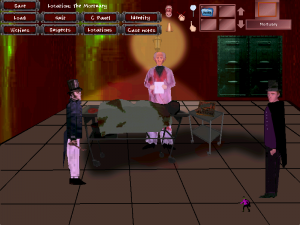 JACK is based on the real-world 19th century serial killings in London’s Whitechapel district. Actual pictures of the victims and suspects are used in the game, as well as authentic autopsy reports. Most of JACK takes place in the dark, and the graphics are predictably dark and gloomy. They are not very detailed, which makes it a bit hard to spot all the small clues Charles has to find, but there is never any serious pixel hunting necessary. The world is shown in third-person view, and some screens move as Davenport walks through them. The layout of the murder locations is fairly accurate, although it's a bit strange that you don't get to see the backyard where Annie Chapman was killed. The music is very simple and repetitive but not intrusive and fits the mood of the game well. There are only a few mediocre sound effects, like waves on the Thames shoreline and the whoosh of an arrow. The game doesn't have voices yet, but a voiced version is scheduled for the spring. For now, all spoken texts are shown in color-coded fonts that are largely readable, except for the dark blue color used against a very dark background.
JACK is based on the real-world 19th century serial killings in London’s Whitechapel district. Actual pictures of the victims and suspects are used in the game, as well as authentic autopsy reports. Most of JACK takes place in the dark, and the graphics are predictably dark and gloomy. They are not very detailed, which makes it a bit hard to spot all the small clues Charles has to find, but there is never any serious pixel hunting necessary. The world is shown in third-person view, and some screens move as Davenport walks through them. The layout of the murder locations is fairly accurate, although it's a bit strange that you don't get to see the backyard where Annie Chapman was killed. The music is very simple and repetitive but not intrusive and fits the mood of the game well. There are only a few mediocre sound effects, like waves on the Thames shoreline and the whoosh of an arrow. The game doesn't have voices yet, but a voiced version is scheduled for the spring. For now, all spoken texts are shown in color-coded fonts that are largely readable, except for the dark blue color used against a very dark background.
At the top of the screen are buttons for different functions, like the lists of victims and suspects, the verbs you can use (look, walk, smell etc.), as well as the inventory. The action verbs can also be cycled through using the right mouse button. There are many different puzzles, and you have to use everything at your disposal to find all the clues available. Some of the clues are well hidden so vigilance, patience and some creativity is needed to find them all. Since the real killer was obviously never found, the story is only loosely based on real events, but it is nicely conceived. Events follow each other naturally and the puzzles, although not very hard, are well thought out and logical. The suspense slowly increases as you come closer to discovering the murderer, which makes you want to keep on playing to the end. However, this is a long game and you will probably not be able to finish it in one sitting. Despite the gloomy looks and mediocre audio backdrop, this game is well worth playing, especially for those fascinated by the Ripper’s famous unsolved mysteries. It is not for the faint of heart, however: these murders were truly gruesome, and the autopsy reports describe the state of the corpses in vivid detail.
JACK can be downloaded from the Adventure Game Studio website.
Goat Herd and the Gods
The short game Goat Herd and the Gods by Dropped Monocle Games takes place somewhere in South America at a time before the Spaniards arrived. Young Aztec goat herder Atl is dozing under a tree when suddenly he hears his goats mee-e-e-e-eh in great distress. He hurries to them just in time to see the last goats being picked up by El Chupacabra, a horrible goat-sucking monster with big fangs and talons. Realizing that if he doesn't get his goats back he will be next on the offering block, young Atl turns to his gods for help. After they get some good coffee from Atl, they agree to help him with a special concoction that will give him superpowers to defeat El Chupacabra. But Atl, being a resourceful young fellow, decides to modify the concoction a bit to make it better than even the gods themselves realized.
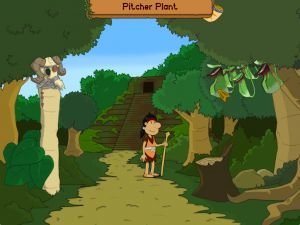 The story is presented in a cheerful manner, with Atl walking around with a continuous smile on his face. Goat Herd and the Gods is played in third-person mode and displayed in colorful, static cartoon screens drawn in uniform colors, some of which move as Atl walks through them. The sound effects, like Atl's footsteps and the coffee beans roasting, are accurate. All Atl's actions are accompanied by soft music consisting mainly of flutes and drums, at low volume, the tune depending on the location in which Atl currently finds himself. There are no voices in the game, but all text is shown on screen in a nice, sharp font in bright colors.
The story is presented in a cheerful manner, with Atl walking around with a continuous smile on his face. Goat Herd and the Gods is played in third-person mode and displayed in colorful, static cartoon screens drawn in uniform colors, some of which move as Atl walks through them. The sound effects, like Atl's footsteps and the coffee beans roasting, are accurate. All Atl's actions are accompanied by soft music consisting mainly of flutes and drums, at low volume, the tune depending on the location in which Atl currently finds himself. There are no voices in the game, but all text is shown on screen in a nice, sharp font in bright colors.
Atl is controlled with the mouse, with both buttons used to make him look at and interact with objects in his environment. Hotspots are indicated by a short description in a special box at the top of the screen, and clicking on a goat's horn attached to this box brings up the inventory. Atl walks a lot and very slowly by default, but luckily you can increase his pace in the menu settings. Most of the puzzles are inventory-based, but Atl also has to make direct use of items in his environment and he has a long and complicated discussion with the gods that goes on forever if you don't know the right things to say. No need to rush through the dialogue, however, as the conversation is quite hilarious. This being a short game, there aren't many puzzles to solve, but the ones included are fun and logical, and not too easy. All in all, Goat Herd and the Gods is an entertaining game and I hope Dropped Monocle will release longer games of this quality in the future.
Goat Herd and the Gods can be downloaded from the Adventure Game Studio website.
Yurius's House of Spooks
Uncle Vova has bought his nephew a remote-controlled aeroplane for his birthday. Whilst playing with it in the garden that evening, the boy inadvertently flies the plane through the window of his mad neighbor Yurius. Yurius's house is a crooked old thing, just like the owner himself. When Uncle Vova rings the doorbell, he is quickly captured by Yurius and thrown in the cellar. Now Vova has to escape and get his nephew's aeroplane back. To do that, he must distract the mad Yurius, bring blood to a vampire, and clean a statue, among other tasks.
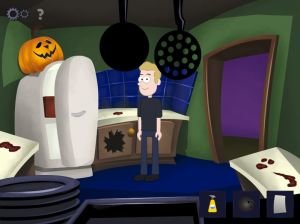 Yurius's House of Spooks, by Carmel Games, is yet another fun game by the studio we know so well. All the familiar elements are present in the game: excellent voice acting, colorful cartoon graphics with hardly any straight or parallel lines, wacky characters and fun puzzles. The music, a very short tune that is repeated forever, fits the mood of the game well, but can be turned off if it becomes too repetitive. The sound effects are excellent; you’ll hear the creaking or slamming of doors, the roar of the plane's engine, and even the sounds of cleaning a statue are effective.
Yurius's House of Spooks, by Carmel Games, is yet another fun game by the studio we know so well. All the familiar elements are present in the game: excellent voice acting, colorful cartoon graphics with hardly any straight or parallel lines, wacky characters and fun puzzles. The music, a very short tune that is repeated forever, fits the mood of the game well, but can be turned off if it becomes too repetitive. The sound effects are excellent; you’ll hear the creaking or slamming of doors, the roar of the plane's engine, and even the sounds of cleaning a statue are effective.
There is not much of a story to this game; you just have to search Yurius's house and make use of the things you find to complete your quest. As with all Carmel’s games, Yurius's House of Spooks is played using only the left mouse button. Inventory items appear at the lower right corner of the screen and a button that brings up a walkthrough can be found in the top left. You probably won’t need the latter, however, as all puzzles in this game are inventory-based and not very hard. I finished the game in less than 15 minutes.
Yurius's House of Spooks can be played online at JayisGames.
Other new releases
Not all games are created equal, and freeware games especially come in all shapes and sizes. Not to be overlooked, the following list might also be of interest, though these games may be significantly shorter or less polished, more experimental titles than those detailed above, some perhaps only borderline adventures to begin with.
It Moves by SnowOwl – A coveted room of his own ends up the site of horrific nightmares for a young boy.
The Inquisitor by Malcolm Brown – Solve murders in this procedurally generated game where the story is never the same twice.
Scare Dare: The House by Stefanie Hartung – Taking that dare to go into the old abandoned house is looking more like a bad idea by the minute.
Forest of Drizzling Rain by Sanada Makoto – When her parents are killed, a young girl discovers her past is not what she thought it was.
Nekra Psaria 2 by DrawManEater – Travel through a surreal and confusing world as you try to find your way home.
Skullz by Pizzamakesgames – Even when you wake up not knowing who you are, following the advice of a nearby skull may not be a wise move in this bizarre tale.
The Man in the Hat by Antonio Bernal – Help the man in the hat get comfortable on his terrace with a drink and some music to listen to.
The Empty Kingdom by Daniel Merlin Goodbrey – A king wanders through his kingdom, mysteriously deserted by all its inhabitants, leaving him the only one left.
Maplewood Junior High by Carmel Games – Find a working computer and construct an essay on global warming in a computer lab abandoned in the 1990s.
That’s it for this month. Think we’ve missed a gem or want to tell us about your own game? Then pop in to our Adventure forum and tell us about it!
Stephen Brown and Willem Tjerkstra contributed to this article.





